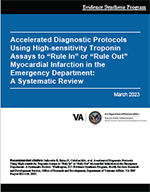
|
Recommended citation: |
Download PDF: Complete Report, Executive Summary, Report, Appendices
Accelerated diagnostic protocols (ADPs) that incorporate high-sensitivity cardiac troponin (hs-cTn) discharge more patients from the emergency department (ED) to the community and have no difference in cardiovascular events and death compared with hs-cTn alone. ADPs with shorter hs-cTn testing intervals reduce ED length of stay more than longer testing intervals without compromising clinical outcomes. Among ADPs that reduce length of stay, there is no obvious best choice and any ADP may need to be tailored to local context.
In the United States, 7 million people annually visit the ED for chest pain, but only 4% of these patients are diagnosed with myocardial infarction (MI). Multiple ADPs that incorporate hs-cTn have been proposed to help ED providers quickly rule out MI. The primary objective of this review was to evaluate the effectiveness and comparative effectiveness of ADPs that use hs-cTn on clinical and health service use outcomes.
Eligible studies included 2 randomized controlled trials (N=32,050), 5 nonrandomized comparative studies (N=18,377), and 10 studies (N=44,016) evaluated as single group design. Studies reported on 23 ADPs that incorporate hs-cTn. A single pre-post study compared an ADP with hs-cTn to hs-cTn alone and found that the ADP increased discharges from the ED to the community without differences in cardiovascular outcomes or death between groups. ADPs with shorter compared to longer hs-cTn timing reduced ED length of stay and increased discharges to the community without differences in clinical outcomes by group. In studies that compared different risk scores used in ADPs, the HEART ADP compared to the TIMI ADP reduced ED length of stay and increased discharges to the community without differences in clinical outcomes. In indirect comparisons across studies, ADPs that measured hs-cTn for up to 12 hours had longer ED lengths of stay than ADPs with ≤ 6 hours of measurements.
Accelerated Diagnostic Protocols Using High-sensitivity Troponin Assays to "Rule In" or "Rule Out" Myocardial Infarction in the Emergency Department: A Systematic Review (Management eBrief)